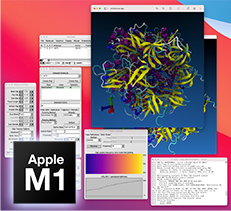Highlights of our Work
2024 | 2023 | 2022 | 2021 | 2020 | 2019 | 2018 | 2017 | 2016 | 2015 | 2014 | 2013 | 2012 | 2011 | 2010 | 2009 | 2008 | 2007 | 2006 | 2005 | 2004 | 2003 | 2002 | 2001

Made with VMD
VMD supports the broadest possible range of hardware platforms of value to
molecular scientists. ARM processors have dominated mobile phone and
tablet platforms due to their energy efficiency and customizability. Our
investigation of GPU-accelerated ARM platforms for molecular modeling
demonstrated their potential, as
as we previously reported. Recently
ARM platforms have become significantly more performant, with today's
state-of-the-art 64-bit ARM CPUs beginning to turn up in top ranked
supercomputers, public clouds such as AWS, and both laptop and desktop
PCs. Apple has released new Mac laptop and desktop computers based on its
own "M1" 64-bit ARM processors. VMD 1.9.4 adds support for the new Apple
M1 platform and MacOS 11, a major new version of MacOS that supports
hardware based on both Intel x86 and Apple ARM M1 processors. The new VMD
builds for Apple M1 platforms uses 64-bit addressing to facilitate
efficiently working with very large macromolecular systems and
biomolecular complexes limited only by memory capacity. To provide the
best possible performance on the new ARM-based platforms by Apple and
other vendors, VMD incorporates hand-vectorized loops for NEON SIMD
instructions, enabling rapid alignment of atomic structures with cryo-EM
densities, and interactive animation of molecular surfaces with
QuickSurf, and molecular orbital visualizations from quantum chemistry
calculations and hybrid QM/MM simulations. The new VMD builds for Apple
M1 Mac hardware are available
from the VMD home page.



